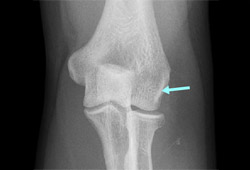Summary
Definition
History and exam
Key diagnostic factors
- history of repetitive recreational or occupational activity
- past medical history of epicondylitis
- smoking
- elbow pain during or following flexion and extension
- exacerbation of pain with repetitive movement or occupational activity
- decreased grip strength
- pain at the lateral aspect of the elbow (lateral epicondylitis)
- tenderness over the common extensor tendon (lateral epicondylitis)
- positive extensor carpi radialis brevis stretch (lateral epicondylitis)
- pain during resisted wrist and digit extension (lateral epicondylitis)
- pain at the medial aspect of the elbow (medial epicondylitis)
- tenderness approximately 5 mm distal and lateral to the medial epicondyle (medial epicondylitis)
- increased pain with resisted forearm pronation or wrist flexion (medial epicondylitis)
Other diagnostic factors
- normal range of movement at elbow
- normal sensation
- Tinel sign negative
- weak wrist extension (lateral epicondylitis)
- swelling
Risk factors
- increasing age (>40 years)
- past medical history of epicondylitis
- repetitive activities
- poor mechanics during activities
- improper equipment
- inadequate physical conditioning
- smoking
- obesity
- symptoms occurring on the same side as hand dominance
- female sex
Diagnostic tests
1st tests to order
- no initial tests (clinical diagnosis)
Tests to consider
- elbow x-ray
- computed tomographic scan of the elbow
- MRI of the elbow
- MRI of the cervical spine
- electromyogram and nerve conduction studies
- ultrasound of the elbow
Treatment algorithm
initial presentation
no response to initial treatment at 6 weeks
lateral epicondylitis refractory to treatment 6-12 months after initial presentation
medial epicondylitis refractory to treatment 6-12 months after initial presentation
Contributors
Authors
Adam C. Watts, BSc, MBBS, FRCS (Tr and Ortho)
Consultant Hand and Upper Limb Surgeon
Wrightington Hospital
Appley Bridge
Wigan
UK
Disclosures
ACW has received payment for education from Medartis and Wright Medical. His institution has received funding for research from Chemedica, ZimmerBiomet, Wright Medical, Stryker and Lima.
Paul M. Robinson, FRCS (Tr&Orth), BMedSci, MBChB (Hons)
Consultant Trauma and Orthopaedic Surgeon
Peterborough City Hospital
North West Anglia NHS Foundation Trust
Peterborough
UK
Disclosures
PMR declares that he has no competing interests.
Acknowledgements
Dr Adam C. Watts and Dr Paul M. Robinson would like to gratefully acknowledge Dr Len Funk, Dr Iain Macleod, Dr Daniel J. Soloman, and Dr Hugo B. Sanchez, previous contributors to this topic. LF, IM, DJS, and HBS declare that they have no competing interests.
Peer reviewers
Frank G. Alberta, MD, FAAOS
Associate Professor of Orthopaedic Surgery
Hackensack Meridian School of Medicine
Nutley
NJ
Disclosures
FGA declares that he has no competing interests.
Peer reviewer acknowledgements
BMJ Best Practice topics are updated on a rolling basis in line with developments in evidence and guidance. The peer reviewers listed here have reviewed the content at least once during the history of the topic.
Disclosures
Peer reviewer affiliations and disclosures pertain to the time of the review.
References
Key articles
American College of Radiology. Practice parameter for the performance and interpretation of magnetic resonance imaging (MRI) of the elbow. 2021 [internet publication].Full text
American College of Radiology. ACR appropriateness criteria: acute elbow and forearm pain. 2024 [internet publication].Full text
Raman J, MacDermid JC, Grewal R. Effectiveness of different methods of resistance exercises in lateral epicondylosis - a systematic review. J Hand Ther. 2012 Jan-Mar;25(1):5-25. Abstract
National Institute for Health and Care Excellence. Autologous blood injection for tendinopathy. Jan 2013 [internet publication].Full text
Reference articles
A full list of sources referenced in this topic is available to users with access to all of BMJ Best Practice.

Differentials
- Radial tunnel syndrome
- Radiocapitellar plica
- Osteoarthritis
More DifferentialsGuidelines
- ACR Appropriateness Criteria: acute elbow and forearm pain
- Lateral epicondyle tendinopathy (LET) toolkit
More GuidelinesPatient information
Tennis elbow
More Patient informationLog in or subscribe to access all of BMJ Best Practice
Use of this content is subject to our disclaimer